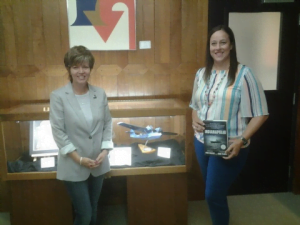
The authors of “Indianapolis – The True Story of the Worst Sea Disaster in U.S. Naval History and the Fifty-Year Fight to Exonerate an Innocent Man,” Lynn Vincent and Sara Vladic, gave a presentation to approximately 150 individuals in the Skanta Theatre at the Frankfort Community Public Library Monday night.
Both Vincent and Vladic were in Frankfort to discuss their latest book which has reached number five on the list of current best sellers in the country. The book was released on July 10. Vincent is a #1 New York Times Best Selling author Lynn Vincent and Vladic is a National Geographic Historian.
You may be familiar with the story of the USS Indianapolis sinking, but this is the first time, thanks to years of original research and extensive interviews with 107 survivors, that the complete story of the worst sea disaster in United States naval history has been told. Notably, INDIANAPOLIS includes the 50-year fight to exonerate the ship’s captain after a wrongful court martial, among other ground-breaking revelations.
Just after midnight on July 30, 1945, days after delivering the components of the atomic bomb from California to the Pacific Islands in the most highly classified naval mission of the war, the USS Indianapolis –the flagship of the WWII Pacific fleet – is sailing alone in the center of the Philippine Sea when she is struck by two Japanese torpedoes. The ship is instantly transformed into a fiery cauldron and sinks within minutes. Some 300 men go down with the ship. Nearly 900 make it into the water alive. For the next five nights and four days, almost three hundred miles from the nearest land, the men battle injuries, sharks, dehydration, insanity, and eventually each other. Only 316 will survive.
Because of meticulous research and survivor relationships cultivated over the last 17 years, Vincent and Vladic are able to take the reader into the action like never before. They give a visceral, heart-rending, moment-by-moment account of the chaos on board the sinking ship and the first moments of shock as the crew plunge into the sea. They reveal the untold stories of the crew left adrift for five days in the Philippine Sea, as terror and hunger morph into delusion and desperation, as well as those of the heroic rescuers, many of whom were only teenagers. Vincent and Vladic also chronicle the top-secret mission by an Army spy to shepherd the core of the first atomic bomb, Little Boy, aboard the Indianapolis; and the hidden history of the Top Secret ULTRA program that could have saved the ship.
Finally, the authors go beyond the men’s rescue to tell the story of the Indianapolis’s extraordinary final mission: the survivors’ 50-year fight for justice on behalf of their skipper, Captain Charles McVay III, who is wrongly court-martialed for the sinking. What follows is a captivating courtroom drama that weaves through generations of American presidents, from Harry Truman to George W. Bush, and forever entwines the lives of three captains—McVay, whose life and career are never the same after the scandal; Mochitsura Hashimoto, the Japanese sub commander who sinks Indianapolis but later joins the battle to exonerate McVay; and William Toti, the captain of the modern-day submarine Indianapolis, who helps the survivors fight to vindicate their captain.
A sweeping saga of survival, sacrifice, justice, and love—unfolding against the larger war and the historic actions of titans of the era — INDIANAPOLIS stands as both groundbreaking naval history and spellbinding narrative. It is the definitive account of one of the most remarkable episodes in American history.
Earlier this year, the Navy has completed a formal review of the final crew accounting in the World War II loss of heavy cruiser USS Indianapolis (CA 35).
Details are included in a research paper published March 20 by the U.S. Naval Institute’s Proceedings Today in which Naval History and Heritage Command historian Richard Hulver, Ph.D. collaborated with filmmaker and Vladic to share information from their independent research into the matter.
The review concludes the following:
• At the time Indianapolis was torpedoed, there were 1,195 Sailors and Marines onboard (the number was previously believed to be 1,196).
• Although it may never be known precisely how many of the crew survived the sinking of the ship and entered the water, the review concludes 879 Indianapolis Sailors and Marines lost their lives either in the attack on the ship, in the water following the ship’s sinking, or after rescue (the number was previously believed to be 880*).
• The total number of Sailors and Marines who survived the sinking of the ship was 316 (this is the number always maintained by the Navy).
Hulver’s review was ordered by Sam Cox, Director of the Naval History and Heritage Command (NHHC) in the wake of the discovery of the ship’s wreck by a research team led by entrepreneur and philanthropist Paul G. Allen last summer. After the discovery of the ship’s wreck, the long-held belief by some reemerged that a flaw existed in the Navy’s official, final crew accounting conducted immediately following the ship’s loss. It was believed by some that the final number of Sailors and Marines who survived was 317 not 316 as the Navy, the Court of Inquiry, and the ship’s commanding officer Capt. McVay stipulated Aug. 8, 1945.
Current NHHC staff had not seen research that pointed to 317 survivors, although there was discussion in various articles, including a September 2017 Proceedings Magazine article by Vladic who believed the Sailor who was not accounted for in the Navy’s tally was Petty Officer Second Class Clarence W. Donnor who went on to serve in the Navy until his discharge in July 1946.
As it turns out, she was right and Donnor was the key to the mystery, but not the 317th survivor.
